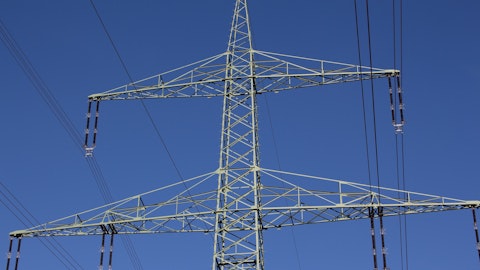Chris Womack: Good afternoon.
Jeremy Tonet: Just wanted to come in, I guess, on the debt funding side, if I could start. I understand the Georgia Power debt funding increase driven by the IRP there. But at the holdco, just wondering what’s the main contributor to the kind of big step up there of expected debt issuance? It looks like several billion in the 2024 plan now, and I think it was much less than that before. So just kind of curious, I guess, on the holdco debt issuance step-up expectations.
Dan Tucker : Yes. So in terms of the change kind of planned versus plan, Jeremy, it’s largely driven by the CapEx as well, right? I mean, ultimately, the parent company is funding Georgia Power’s equity contribution. And while we’re financing that partially with new equity through our plans, certainly — it’s certainly not all being funded directly with new shares. So there’s incremental debt there. And then just the overall magnitude of the parent company issuances is largely driven by maturities. If you look a couple of pages beyond, there’s, I think, over $5 billion worth of maturities in the same time period. So the amount that’s kind of new money is much smaller.
Jeremy Tonet: Got it. Thanks for that. And just curious if you’re able to share any thoughts on the Georgia PSC elections here. Just as far as from what you guys see inside the state for those pending elections. Do you expect the ballot in the elections to happen before the November general election? Or do you think it all kind of comes in November? Just kind of curious, I guess, how you think timing could shape up there?
Chris Womack: I have no idea. I mean that matter is still in the court system. And so we’ll observe it, just like you are. But I have no insight into how that’s going to play out at this time.
Jeremy Tonet: Got it. And just a quick last one, if I could. If you guys are running an RFP process in the Georgia IRP, and how you think Southern Power — Georgia Power stacks up, I guess, in RFP process there?
Dan Tucker: Look, just in answering that, generally, Jeremy, I mean, and we’ve said this before, the IRA is going to position all of our electric utilities to be much more competitive in these self-build options when it comes to resources, whether or not it plays out in this particular RFP, or it’s a subsequent RFP, or it’s a customer-specific siding, those things will happen over time. But it’s also likely a function of something later in the plan. So not a 2024, 2025, maybe not even 2026 kind of resource. We’re talking really towards the back end of the plan where that becomes a real opportunity.
Jeremy Tonet: Got it. That’s helpful. I’ll leave it there. Thanks.
Chris Womack: Thank you.
Operator: Thank you. Our next question is from the line of Durgesh Chopra with Evercore. Please go ahead. Your line is open now.
Chris Womack: Hey, Durgesh.
Durgesh Chopra: Hey, good afternoon team. Just — is there a way for us to give us a range? And I understand if you can’t. But just in terms of the current capital plan, was that the Georgia IRP? What I’m after is what looks like a successful outcome there as we await the April decision? Just trying to see what is baked into the plan and what to look for in that April decision?
Dan Tucker: Yeah. It’s a fair question, Durgesh. But this is where I want to stop short of getting ahead of any regulatory processes here. We’ve, kind of, characterized in terms of the megawatts that we’ve included that it’s roughly 60% of the brick-and-mortar megawatts that were proposed. And so the best way for me to characterize it without getting ahead of anything is just say that the incremental capital associated with what we didn’t include won’t be lost in the rounding. It’s a pretty meaningful number.
Durgesh Chopra: Understood. I appreciate that, Dan. And then as we think about just along those lines, incremental CapEx upside. Is there a rule of thumbs, again, just for our models, high level, how should we think about it getting financed? You’ve got some strong load growth. But when we’re thinking about higher CapEx, what percentage could be equity finance versus debt? Any guidance there?
Dan Tucker: Yeah. I think what we’ve done with this update is pretty representative of how we think about additional opportunities. So we added $5 billion of capital of this plan, let’s call that $1 billion a year on average. We’ve added roughly $350 million of equity every year. So that 35% to 40% range is representative of our consolidated equity ratio and represents pretty well what we think is necessary to maintain if not marginally improve, but really just maintain the credit profile that’s already in a really good place.
Durgesh Chopra: Very clear. Thank you so much. Appreciate the time guys.
Chris Womack: Thanks, Durgesh.
Operator: Thank you. Our next question is from the line of Andrew Weisel with Scotiabank. Please go ahead. Your line is now open.
Chris Womack: Hi, Andrew.
Andrew Weisel: Hi. Good afternoon. A couple of quick follow-up questions, really. One, just to clarify, the equity of $350 million per year. That’s through 2026 in the slides. It kind of sounds like you’re saying that’s through 2028. Should we think of that as just a run rate of $350 million per year going forward and potentially more if there’s more CapEx?
Dan Tucker: Yes. So, what that $350 million represents is us turning on what we refer to as our internal plan. So, it’s issuing new shares through our DRIP, through our 401(k), and that’s about the run rate. And it just happens to match up pretty well with the needs associated with the $5 billion of incremental capital. We typically also maintain an at the market plan as flexibility. And so to the extent there’s incremental CapEx that emerges, which again, is certainly reasonably possible given everything we’ve described, the ATM’s the source that we’ll tap into to help finance that.
Andrew Weisel: Okay. Very good. Next, on the CapEx update. Just to clarify, and sorry if I missed it. Does that include anything for Alabama Solar? Or would that be incremental?
Dan Tucker: Yes. No, that would be incremental. There’s still no new rate-based solar included. So, we’ve remained conservative in terms of our projections there in the outlook. And hey, just going back, Andrew, real quickly to the equity question. Just to kind of point out since maybe it wasn’t clear because we only put a three-year financing plan out there, yes, leaving the plans on every year. And on average, kind of the average increase to shares every year is a fraction of a percent. So, that’s also kind of in the rounding.
Andrew Weisel: Sounds good. One last one, if I may. Dividend growth, you’ve been very consistent at $0.08 per share, about 3%. Given the CapEx outlook, is there any point in time at which you might reconsider the trajectory?
Dan Tucker: Another terrific question. So, we had kind of alluded to the possibility of reevaluating the rate of dividend growth once we got Vogtle 4 into service, and kind of had — we’re kind of in a steady state and into the kind of below 70% somewhere. Given our current circumstances where were we are, in a place of issuing equity, perhaps one of the most efficient sources of equity is to remain modest in the way we continue to increase the dividend. So, I think for the foreseeable future, the trajectory we’ve been on is a reasonable expectation for the trajectory we’ll remain on.
Andrew Weisel: Very clear. Thank you so much.
Dan Tucker: You bet.
Chris Womack: Thank you.
Operator: Thank you. Our next question is from the line of Anthony Crowdell with Mizuho. Please go ahead, your line is open.
Anthony Crowdell: Hey good morning Chris, good morning Dan. If I could just pitch up one quick one on the data centers and I guess, the load growth. It seems like we finally are going to get some load growth in this sector, and we’re all looking at data centers has helped. But it seems that maybe the rate design question, we’re all trying to figure out typically a lower-margin customer, large investment requirement. And earlier, you touched on maybe helping with some customer bills. I just — my question is, if you go deeper into that on — is it going to be bigger bill impact and bigger fights and rate design or you don’t think that’s an issue?
Chris Womack: I mean there’s always — there will always be issues. But I think as we look at increased sales, as we look at growth in customers, and then as we work with these new customers, we think this provides us the opportunity to have downward pressure on rates. And so we will work with these customers in terms of their pricing. But once again, I just go back to the fundamentals of increased sales opportunity and this customer growth, how that supports the opportunity for us to put downward pressure all across our customer base to see downward pressure on rates. I mean, we’ll evaluate each customer to ensure that, in fact, does happen, that they put downward pressure on overall rates across the company.
Dan Tucker: Yeah. And Anthony, what it appears a lot of these data centers are beginning to do is prioritize reliable, resilient service over many other things. That gives us the opportunity to price it appropriately for the benefit of everyone else.
Chris Womack: And, yeah, we’ll look at the size, the demand, the timing, there are other factors that will go into making sure that we price service appropriately to those customers.
Anthony Crowdell: Great. Thanks for taking my question.
Chris Womack: You’re welcome. Thank you.
Operator: Thank you. Our next question is from the line of Angie Storozynski with Seaport. Please go ahead. Your line is open now.
Chris Womack: Hi, Angie.
Agnieszka Storozynski: Good morning. Great. I guess — I know that everybody is asking questions on data centers, but I’m just — just again, maybe just taking a step back. So when somebody wants to locate a data center in your service territory, do they just get connected to the grid? Or do they develop their own power sources? Do you actually see that they, for instance, have some preference for non-emitting resources. Do they use you more as a backup power source. Again, just — just, again, trying to understand the dynamics of those data centers being added to in Georgia.





